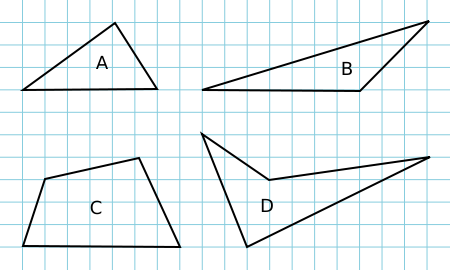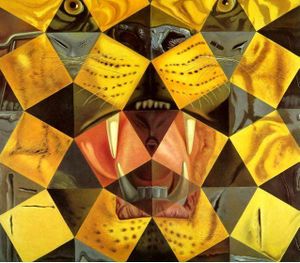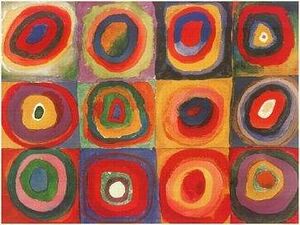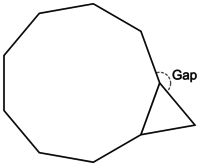Polygonal Tessellation Exercises
- Find all areas of Metamorphosis III which have purely geometric tessellations. Describe each such tessellation, and describe what comes before and after it in the print.
- Problem moved to Recognizable Tessellation Exercises
- Using graph paper, draw a triangle with the same dimensions as triangle A, shown below. Now draw more of
them to tessellate at least 1/4 of the page. Repeat with triangle B, quadrilateral C, and quadrilateral D.

-
- Which of these shapes are convex?
- Which of these shapes can tessellate the plane (be the one tile in a monohedral tessellation)?
A. 
B. 
C. 
D. 
E. 
One pleasing method for tessellating with pentagons was the basis for Escher's Sketch #131-134 (Pentagon tessellations), and Tiled Column, New Lyceum, Baarn. It is shown as the red lines in the sketch on page 106 of Visions of Symmetry. Also on page 106 is a discussion of how to make the pattern. You'll see the "simple grid of squares" if you cut each pentagon in half down its axis of symmetry.
Make a good sized (half page) sketch of this pentagon tessellation on graph paper. If you want, use two colors to emphasize the "overlapped hexagons" as Escher does in Sketch #133 (Mesh).
- A regular polygon has all sides of equal length and all angles of equal measure. Give an example of a polygon which has all equal sides but is not regular. Give an example of a polygon which has all equal angles but is not regular.
- What is the angle sum of an 11-gon? What are the corner angles of a regular 11-gon?
- Explain why you cannot tessellate the plane using copies of a regular -gon, for .
- Draw a tessellation that uses regular octagons and squares.
-
- Draw three tessellations using regular hexagons together with equilateral triangles.
- What are the symmetry groups of your tessellations?
- Calculate the corner angles for the regular pentagon and the regular decagon (10 sides). Explain why you might hope to tessellate the plane using a combination of regular pentagons and regular decagons. Explain why it cannot be done.
- What are the corner angles of a regular 9-gon? If you put a regular 9-gon and a an equilateral triangle together as shown, what regular polygon fits in the gap?
- Tetrominos are tiles made of four squares. There are five possible shapes of tetrominos up to reflection (as any
Tetris player knows):
Using graph paper, show how each tetromino can be used to tessellate. (You need to make five monohedral tessellations).
- Pentominos are like tetrominos but made of five squares. There are 12 of them up to reflection (each
named after a letter it resembles):
Using graph paper, show how each pentomino can be used to tessellate (make 12 sketches!). All of the twelve can tessellate in more than one arrangement, except for one. Which is the pentomino that can only tessellate in one possible arrangement?
- A septomino is made of seven squares. Find a septomino which cannot be used to tessellate the plane.
-

Fifty abstract paintings which as seen from two yards change into three Lenins masquerading as Chinese and as seen from six yards appear as the head of a royal Bengal tiger. Salvador Dali, 1963. Consider the Salvador Dalí painting shown to the right. Explain the title. What are the geometric shapes that make up the tessellation? Is the tessellation regular? Is it Archimedean? Explain your answers.
-

Mondriaan. Broadway Boogie Woogie. 1942-43 These two paintings by Piet Mondrian are tessellations. What geometric shapes are the tiles in these tessellations? Are these periodic tessellations or aperiodic tessellations? Explain.

Mondriaan. Tableau no. 2 / Composition no. V. 1914 -

Farbstudie Quadrate. Wassily Kandinsky, ca. 1913. The painting to the right by Wassily Kandinsky is a tessellation. What geometric shapes are the tiles in this tessellation? Is this a periodic tessellation or an aperiodic tessellation? Explain.
Polygonal Tessellation Exercises Solutions (Restricted access)




